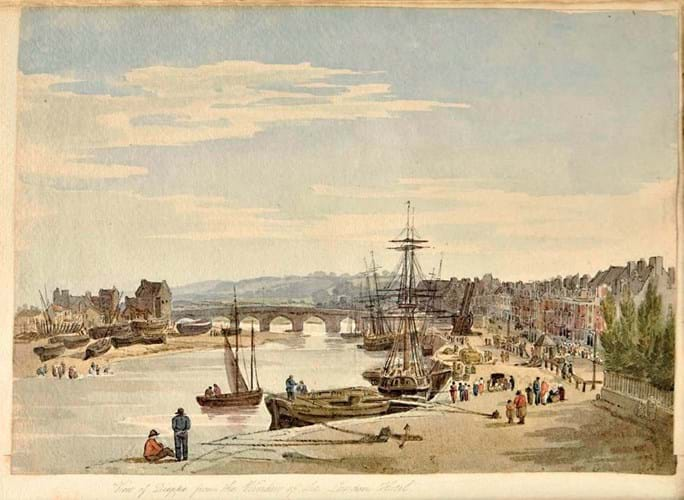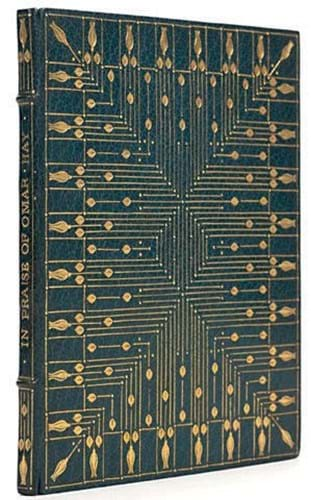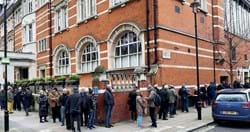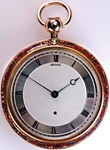A number of rare items relating to early days of the Bank of England changed hands in a recent Gloucestershire sale.
Bid to £1800, the oldest and most expensive of the group sold by Dominic Winter (20% buyer’s premium) on March 4 was a first of an 18pp pamphlet called A Brief Account of the Intended Bank of England.
It was issued anonymously in 1694, the year in which the famous institution was established, and is believed to be the work of the bank’s principal founder, William Paterson.
A copy was sold in Canada in 1977 and this one appeared at Sotheby’s in London two years later, but no other example of this first (and only?) edition has been recorded at auction.
Published in 1695, again anonymously, a 26pp pamphlet called Some Observations upon the Bank of England is also thought to have been the work of Peterson. Issued as a challenge to the bank’s critics, it is a work without any recorded auction presence and sold at £1150.
Bid to £800 was Remarks upon the Bank of England… of 1705, a work whose full title states that it is addressed to the House of Commons. Published as the work of a ‘Merchant of London’, it is thought to have been written by John Broughton, who was concerned that the bank’s powers were becoming too great.
Only once recorded at auction, though present in several UK libraries, was a 1715 work titled The Directors of the Bank of England, Enemies to the Great Interests of the Kingdom… The author was John Holland, who in 1696 had been a principal founder and first governor of the Bank of Scotland. It sold at £660.
Turner prizes

A watercolour view by John Sell Cotman of the harbour at Dieppe from a manuscript journal that Dawson’s Turner’s wife compiled following an 1815 tour of northern France. It sold for £11,000.
Some 40 lots in the sale were a family collection of works that once formed part of the library of Dawson Turner (1775-1858), a member of a well-known banking family who regarded business primarily as a way of supporting his real interests – principally botany – and a passion for collecting that he pursued on a gargantuan scale.
John Sell Cotman was employed as a drawing master in Turner’s household in 1812 and a manuscript broadside of ‘Rules to be observed in Drawing’, produced principally for use by his children, made £2900.
Cotman and Turner became good friends, travelling to Normandy together and collaborating on a book of Architectural Antiquities of Normandy (1822) featuring Cotman’s etchings.
An unsigned watercolour drawing of the waterfront at Dieppe by Cotman was one of 86 drawings, etchings and engravings that illustrate a ‘Journal of a Three Weeks Tour with Thos. Phillips Esqr R.A., from London… to Paris in the Autumn of 1815’. Accomplished in the hand of Mrs Dawson Turner, and including some 20 small drawings by Phillips, it made £13,000.
Among plenty of maps on offer – running to around 100 lots in all – was a copy of Saxton’s Pembrokeshire map of 1587 that, with some later enhancement of otherwise contemporary colour, made £2100.
A monumental four sheet wall-map of the …Country Twenty Miles Round Mansfield by George Sanderson, dated 1835, realised £560.
'Gamesters and Celebrated Sharpers'

The frontispiece and title-page of a rare 1714 first of a work on the lives and intrigues of '…Famous Gamesters and Celebrated Sharpers…' that sold for £1200 at Dominic Winter via thesaleroom.com. The author’s name, Theophilus Lucas, it is suggested, may well be a pseudonym. In a contemporary mottled calf binding it bears the later bookplate of Prince Augustus Frederick, Duke of Sussex (1773-1843).
Sirloin starter
Sold at £3000 was a rare broadside menu titled Notes of the Diet, at Hoghton, at the King’s coming there. It details what was consumed at the residence of Sir Richard Hoghton during a 1617 visit made by James I and his retinue.
Journeying from Scotland back to London, the king was accompanied by his favourite, George Villiers, 1st Duke of Buckingham, along with the Earls of Pembroke, Richmond, Nottingham and many others.
The menu details what they consumed at Sunday dinner and supper, as well as the following day’s breakfast.
According to one local legend, this was the occasion at which the king, impressed by a beef dish, knighted it as ‘Sir Loin’.
This menu was the first of three versions to be printed in later years, and was made for a Sir Henry Hoghton around 1790.
Sold at £4200 was a Commonwealth-era broadside petition of 1651 urging legal reforms in relation to debt, The Women’s Petition to… General Cromwell.
Bid to £1300 was a three-piece lot that included a disbound 1787 first of Six Narrative Poems by Elizabeth Cobbold, though issued under the pseudonym of Eliza Knipe.
Dedicated to Sir Joshua Reynolds, its most significant inclusion was ‘Atombaka and Omaza’, which has been described as a “remarkably powerful example of anti-slavery verse”.
Also in the lot was Hannah More’s The Twelfth of August; or the Feast of Freedom of 1819, which commemorates the abolition of domestic slavery in Ceylon.

Used as the catalogue cover illustration by Dominic Winter was a morocco gilt binding made for an 1896 US edition of In Praise of Omar…, an address given to the Omar Khayyam Club by John Hay, an American lawyer, writer and statesman. The binder is identified only by the initials, LGW, most likely for the English binder Lucy Gilchrist Wrightson. It sold for £1800.
A footnote to a report in ATG No 2431 that recorded the sale of a 1682 work called A Tryal of Witches sold by Sworders for £5400 noted that another was to feature in this Dominic Winter sale. It sold at £2900.













